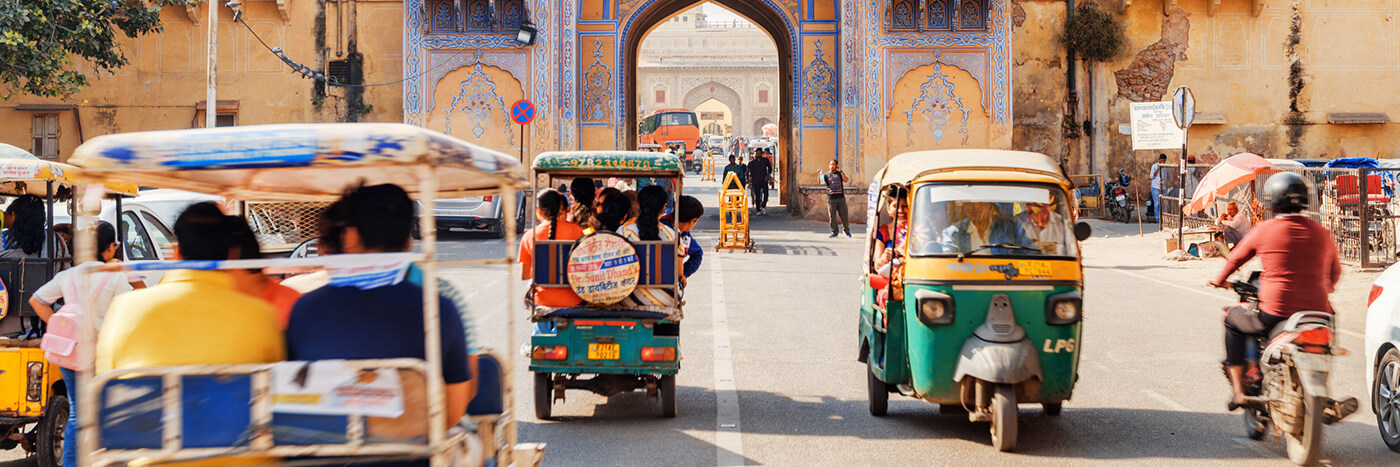
The Covid-19 pandemic has caused unprecedented damage to the global economy, dramatically impacting the movement of people and disproportionately impacting workers most vulnerable to economic downturns. In India, this is most acutely evident in the mass migration of daily-wage workers from urban to rural areas at the height of Covid-19 shelter-in-place, and seeking work back in the cities as restrictions were lifted. Compounding their economic crisis is the lack of access to safe, affordable, and clean transportation options.
As usage of public transportation is likely to continue plummeting, demand for trips by three-wheelers is expected to grow in comparison to other shared mobility options. And thus, at this intersection of health, mobility, and the economy lies an opportunity to help sustain livelihoods in a way that provides clean transportation to the masses: electrification of India’s ubiquitous rickshaw.
A rickshaw is traditionally a pedal-run or motorized three-wheeled vehicle that operates as an informal taxi and dominates passenger mobility in India. Roughly 8 million auto-rickshaws are on the roads across the country and they are the main source of daily income for millions of drivers as well as a major mode of transportation across income groups.
Electrification of fossil-based rickshaws and the integration of locally assembled e-rickshaws (battery-operated) is the key to clean energy transition. However, high upfront costs, lack of financing options, and lack of awareness about supportive policies and charging options remain major barriers.
Considering the scale of the opportunity to sustainably empower vulnerable communities, this is an ideal moment to break down barriers to rickshaw electrification and catalyze a transition toward just, equitable, and inclusive transport across India.
Rickshaws for air, health, and climate
In 2017, poor air quality contributed to 1.2 million premature deaths in India. Accelerating the electrification of rickshaws could improve millions of lives by reducing respiratory illnesses and premature deaths related to air pollution. In the long run, electrification of three-wheelers will have huge climate benefits given that they were the fastest growing segment of the automotive market before the pandemic, while auto demand remained depressed during this period. While the sales may be impacted by the economic downturn, three-wheelers are still in the lead.
Currently, there are an estimated 210 million two- and three-wheelers in India, or 83% of all vehicles, compared to 2 million private light-duty vehicles. The volume of these small vehicles is a major source of growing greenhouse gas emissions, roughly 20% of all transport-related emissions in the country. Achieving 80% penetration of electric three-wheelers by 2030 will lead to an estimated 195 million tons of net CO2 savings over the vehicles’ lifetime. Prompted by national FAME I and FAME II regulations, India is already home to 1.5 million battery-powered e-rickshaws, which transport about 60 million people per day. Philanthropic support can help foster favorable conditions for these vehicles to reach 80% penetration by convening diverse stakeholders, enabling advocacy and shared learnings across geographies, and facilitating innovation in financing mechanisms.
Rickshaws: Market edge for energy transition
The commercial purpose of rickshaws provides a key advantage for electrification, as drivers already have an incentive to keep the operating costs down, and fleet operators to innovate for improved efficiency. Similarly, mobility service providers are an ideal market-scaling mechanism, as they are already offering renting options to drivers across major cities.
Commercial operators can also facilitate the roll-out of charging infrastructure, servicing and maintenance depots, and battery management practices, as seen through a rise of innovative start-ups with battery swapping and operations services. Research shows that, in comparison to a light-duty vehicle, electric three-wheelers can achieve cost parity with fossil-based counterparts much faster due to lower maintenance costs and power requirements, resulting in lower dependency on charging infrastructure. As charging options to service three-wheelers grow, this is expected to yield a cascading benefit to two-wheelers, by supporting higher customer trust and encouraging uptake.
Current government subsidies coupled with additional financing mechanisms can accelerate electrification of rickshaws, generating additional economic benefits for personal and commercial ownership. For instance, research by CRISIL, a global analytics company, estimates that even though the post-subsidy acquisition cost of a lithium-ion powered e-rickshaw is broadly the same as an combustion-driven three-wheeler, the lower running cost can lead to considerable savings for the driver each day. As the market is starting to expand through early adoption of electric mobility and manufacturers are ramping up production and offering new e-rickshaw models, breaking down the remaining barriers in first-mover markets, like small electric vehicles, will accelerate the transition to fossil-free mobility.
Philanthropy for rickshaws
The many benefits of electrifying three-wheelers — such as financial inclusion, access to low-cost mobility, reduced emissions, improved air quality, and economic benefits — coupled with healthy market projections, underscore the significance of greater collaboration between the Indian government and the automotive industry in supporting and accelerating the transition in this mobility segment.
Philanthropic investment in this space should focus on three key areas:
- Name the stakeholders and the roadblocks. The complexity of the regulatory environment, economic value of the informal mobility market, and past efforts at electrification, require a comprehensive assessment of the key players in the space, social value associated with electrification of three-wheelers, approaches that have been tested, and the resulting gaps that need to be closed. The landscape assessment should look into questions such as:
- What public-private interventions and financing options can support and accelerate adoption, especially among low-income groups?
- For low-income drivers, what are some of the benefits associated with renting as opposed to owning three-wheelers? Are there any case studies from fleet owners in major cities?
- What set of policies can enable more registration of electric three-wheelers without impacting livelihoods?
- Bring the stakeholders together. The dialog platform bringing together representatives from government, industry, the NGO community, and labor or representation from community of informal workers, should work to advance key policies, specifically:
- An optimal regulation framework for three-wheelers,
- An incentive structure to support uptake,
- Financing structures for drivers to transition to electric rickshaws,
- Innovative business models both for renting and operating three-wheelers, as well as battery swapping, and many others.
- Make it work. Establish a comprehensive pilot in a champion city in order to build on lessons learned from past efforts and to showcase a legitimate pathway for electrification of three-wheelers in other cities.
The ‘last mile’ on the path toward reaching 100% electrification of rickshaws will require a national-level policy with at least two targets: (1) encouraging manufacturers to produce and sell more electric two- and three-wheelers, through a direct mandate at the state or national level, and (2) disincentivizing the purchase and use of fossil-based rickshaws.
The right set of policies and partnership, coupled with current high ambition, can lead India from economic recovery to electric, inclusive rickshaw mobility. Philanthropy can leverage its convening power to bring together diverse stakeholders with the goal of unlocking the remaining barriers to an accelerated electrification of rickshaws.


